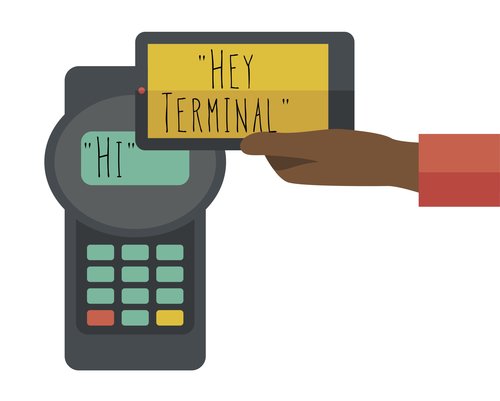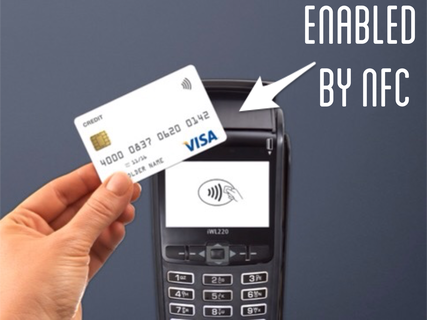What does NFC mean? No further comment? Not from concentrate? No freaking clue? It might mean all those things but in the context that we will be talking about today, it means Near Field Communication. It’s the means by which two devices exchange information.
The term has been a pretty prevalent buzzword over the last few years. Chances are even if you haven’t heard of it, you’ve at least used the technology. If you’ve ever tapped your credit card to pay or used a key pass to gain access into a building, you’ve used NFC.
The down low
NFC is how devices “talk” to each other. It allows 2 devices to communicate (transfer data) through radio signals by tapping the devices together or by bringing them near one another (up to a distance of 10 cm).
Components
Passive (NFC tag): An NFC tag is a chip that has no battery/power source and contains info that other devices can read but is not able to read info itself. When it is activated by an active device, small amounts of data can be transferred.
Active: A device that can read information, as well as send it. A smartphone is an active device; it would not only be able to collect info from NFC tags but exchange info with other active devices as well.
Communication
Two-way communication: involves two devices that can read and write to each other. For example, two NFC-enabled smartphones sharing photos.
One-way communication: involves a powered device reading and writing to devices containing an NFC tag. For example, when you tap your commuter card (NFC tag) on the NFC-powered card terminal, the terminal communicates by subtracting the fare from the card.
Modes
Card emulation mode: NFC-enabled devices, like your phone, acting like a smart card and communicating with a reader. E.g. paying with Google Wallet.
Peer-to-peer mode: two NFC-enabled devices communicating with each other to exchange information with a touch. E.g. sharing games via enabled phones.
Reader/Writer Mode: NFC-enabled devices reading or writing information stored on passive tags. E.g. a smartphone reading an NFC tag in a promotional poster.
NFC & family
NFC is similar to Bluetooth — a cousin if you will. They both allow wireless communication between digital devices such as smartphones. However, there are significant differences between the two.
With Bluetooth, a connection needs to be set up for data transfer, while NFC is automatic. NFC is a brief process, whereas Bluetooth has the capacity to maintain the connection. NFC also uses far less power than Bluetooth but in turn, has a slower speed.
If Bluetooth was the cousin, RFID (radio-frequency identification) would be the grandfather. NFC evolved from RFID with one of the main differences being that NFC is made for close proximity and RFID for long range.
RFID is exclusively one-way communication, such as the technology that highway toll readers use to read cars as they pass. NFC can support both types of communication and is ideal for portable devices such as mobile phones and key fobs.
NFC in the world of payments
The most prolific use that NFC is associated with is payments. I’m sure all of you have paid by tapping your credit card — that is enabled by NFC.
Nowadays, what is increasingly prevalent is an NFC-enabled smartphone that acts like a contactless wallet and allows you to make mobile payments. Electronic wallets are gaining popularity and will only continue to grow with technology darling Apple joining the game.
Users can add credit cards to e-wallets such as Apple Pay, Samsung Pay, Android Pay, or Google Wallet to replace them with a virtual card. Since the credit card information is stored on your phone, NFC enables you to pay with a simple tap. This means any device can be turned into a secure form of payment; Apple Watch lets you pay with a flick of your wrist.
Benefits of NFC mobile payments
Customer ease: With the fast-paced culture that we live in, consumers want it easy, and they want it fast. The more streamlined you can make the experience for customers, the more likely they are to give you their business. People may forget wallets, but they’ll likely always have their phones on them.
Adapt or die: Technology is ever-evolving and society are constantly changing. Increasingly more mobile devices are incorporating NFC technology and more merchants are accepting mobile payments. You can’t afford to miss a sale; your business needs to adapt by letting your customers pay how they want.
Build loyalty. It’s a cutthroat world out there and you need to create incentives for customers to choose you. Mobile payments can help you implement a loyalty program to retain customers and promote repeat business.
Safety
NFC establishes a secure channel and encrypts sensitive information such as credit card numbers. Users can further protect their data by adding a password in case their phone falls into the wrong hands, as well as set up a PIN or touch sensor for each payment.
Compared to RFID, NFC is more secure since you have to be in close proximity to activate. Someone would have to get near enough with a reader to read the contents of your device. That’s not to say that it is foolproof, but you’d likely notice if someone tries to get that close to you.
NFC fits perfectly in our fast-paced society. The technology is already all around us — in key passes, advertisements, transit cards, and more. NFC in payments is especially attractive because it’s instant and convenient.
As much as mobile payments are gaining traction, some barriers are implementation (merchants have to install the proper equipment) and technology (battery life of smart devices need to be improved due to increased usage). But the future for NFC payments looks promising. In particular, millennials seem to be embracing mobile payments with open arms: 44% of millennials would rather use their mobile phone than cash to pay for smaller items.

